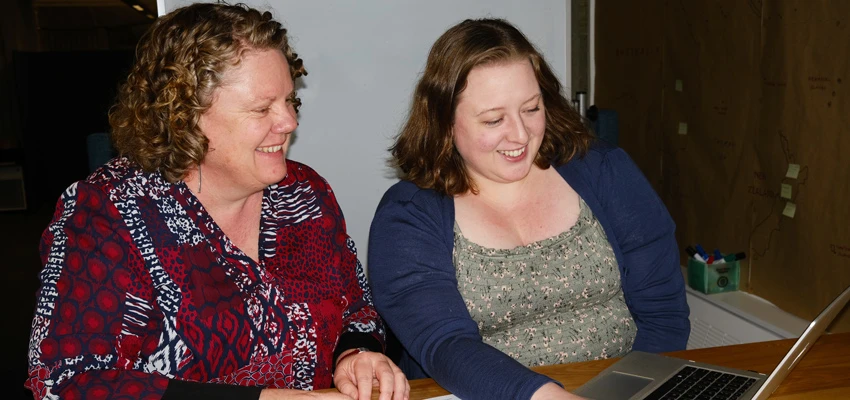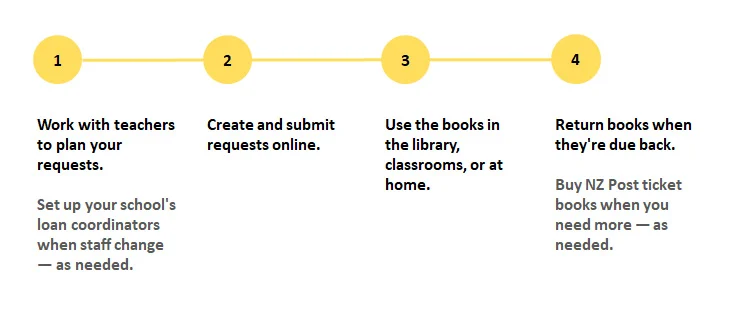Work with teachers to plan your requests for books

Gather information from teachers and your library team about the books they need. Work out how you can get the most from your school's loan allocation, then you can request books online.
Help teachers understand the lending process
One of your important roles as your school's loan coordinator is to explain the lending service to teachers. Arrange a time with teachers to talk about the service before or during their planning meetings.
Teachers need to know:
that you can request books for them every term so their students have new resources for learning and reading for pleasure each term
what information to give you so you can request the type of books teachers need for learning — we have some Word requirement forms to help you gather this information
when you need the information so you can request books at the right time — check our loan request periods and coordinate dates with teachers as they plan for the term.

Diagram description
A flow diagram showing steps within the lending process as follows:
Every term
Work with teachers to plan your requests.
Create and submit requests online.
Use the books in the library, classrooms, or at home.
Return books when they're due back.
As needed
Set up your school's loan coordinators when staff change.
Buy NZ Post ticket books when you need more.
Make loan requests part of your school's regular planning
Loan request periods open before each term starts so that you can request books early.
Dates to request or return books
Find out about the planning cycle in your school to see how this will work with Services to Schools’ loan request periods. It’s helpful to set up a timeline for working through the lending process so that everyone knows what needs to happen and when.
Find out what's needed to support student learning
In a small school, all staff may meet to plan the inquiry topics and literacy focus for the coming term. In this case, the whole staff can decide together what resources they need.
In a larger school, the planning and decision making may happen in teaching teams, syndicates, or department groups. In this case, ask someone from each group to feedback to you after their meetings. Ask your school's literacy leader, library team, or English department staff about what resources they need to support and engage students in reading.
Use our requirements forms to gather details for your online order
Our 2 requirements forms can help you collect all the information you need to request books online. Adapt them to suit your needs or create your own (e.g. set up and share a Google form) to gather teachers’ requirements:
On the back of the forms, there are examples of requests or when you might use the particular requests.
Information for your school's topics selections
The number of topics selection requests your school can make and how many books you can have each term depends on your school's topics selection allocation.
For each topics selection request, you need to specify a learning area and strand, but you can also request a selection for reading engagement.
Before you can enter a request online, you'll need to gather information from your teachers and library team about:
the curriculum learning area and strand, including a brief description and any specific aspects of the topic you want resources for
the reading ages, year levels, and number of students the request will support
the maximum number of books you'd like for this request, and what we should do if we can't provide as many as you'd like.
Our librarians will use this information to select books that match what your school needs.
Topics selection and extra reading requirements form (docx, 91KB) — will help you gather the information you need from teachers and your library team.
Number of books for extra reading
You can have even more books to support reading engagement — an extra 25, 50, 75, or 100 books each term over and above your school allocation.
Ask teachers if they'd like extra reading books and, if so, how many. You can combine their requests up to a maximum of 100 extra reading books for your school.
Information for specific titles requests
You can also request that we send specific books to you.
To request a specific book, you first need to find it in the National Library catalogue and check that a borrowing copy is available.
Ask teachers for the title and author, when they need the book by, and any other information that can help you find the right item in the catalogue, such as:
the ISBN if they know it
details of the reader's needs if a specific edition is required (e.g. large print or dyslexic font edition, or a non-English language version).
Specific title requirement form (docx, 121KB) — will help you gather the information you need from teachers and your library team.
Make the most of your school’s topics selection allocation
To maximise the number of books you receive, you’ll need to use all your available requests.
When you get the requirement forms back from teachers, check to see whether they make good use of your school’s topics selection allocation. If you want to change any requests listed on the forms, confirm with teachers before you go ahead and submit them.
Too few requests to use up my school's allocation
If teachers give you fewer topic requests than your school’s allocation, try doing one or more of the following:
Split one request into several — use different learning areas and strands, year levels, or reading ages to make each request more specific.
Add a cross-curricular request to access a wider selection of books.
Add a reading engagement topic request to supplement your school's library collection. In this case, use a broad description such as 'books to encourage reading for pleasure' as the curriculum topic.
Too many requests for my school's allocation
If you don’t have enough topics selection requests available, try doing one or more of the following:
Combine several requests into one — use the Curriculum topic field to describe what you need.
Replace a broad reading engagement topic request with an extra reading request of up to 100 books. This will free up a topic request that you could use for inquiry. You can’t specify a focus for an extra reading request, but the books will include fiction and high-interest non-fiction titles matched to your school’s profile.
Use a specific title request as an alternative, for example, to support a small number of students or a specific curriculum achievement standard. You can make as many of these requests as you need.
Example — how to maximise your school's allocation
This example shows a school with a roll size of 40 students, and a maximum of 4 topics selection requests each term. They are planning a school-wide inquiry relating to habitats. Using all 4 topic requests (rather than one broad school-wide request) means the school can:
potentially access more books, by splitting one large inquiry focus into several more specific topics
better target their support for particular year levels or reading ages.
School-wide inquiry plan
Curriculum area and strand | Science: Living world |
Inquiry focus | Habitats: rainforests, oceans, rocky-shore, jungles, plains, insects, birds, fish, farming, whales, endangered species |
Reading ages | 5–14 |
Year levels | 1–8 |
Possible selection requests for this school-wide inquiry
Topic request number | Learning area & strand | Learning focus | Year level(s) | Number of students | Reading age (from–to) |
1 | Science — living world | Habitats: rainforests, oceans, rocky-shore, jungles, plains | 1–2 | 8 | 5–7 |
2 | Science — living world | Animals: including insects, birds, fish, whales | 3–4 | 9 | 7–9 |
3 | Technology — nature of technology | Changes in technology and the impact on farming e.g. tractors, milking machines | 5–6 | 12 | 9–12 |
4 | Cross-curricular — science | Endangered species — looking for all curriculum areas, English, art, science, social sciences etc. | 7–8 | 11 | 10–14 |
If you want to limit the number of books you receive
If you want to receive fewer books than your school's allocation, tell us how many you’d like for each topics selection or extra reading request. Our librarians will use this number as a limit for the number of books in your loan.
Use topics selection requests to cater for most students
When your plans accommodate a broad group of students, topics selection requests are the best borrowing option to use. Here are some examples where topics selection requests would be a good option:
a syndicate or class spanning year levels, with a shared curriculum focus for the term — for example, a primary school with 3 junior syndicate classes all learning about habitats
a subject taught across classes at the same year level — for example, all of year 9 studying evolution in science (living world strand)
a year level cohort with widely varying reading ages — for example, intermediate school students whose reading ages range from 8 to 16 years
ESOL students from refugee or migrant families — for example, 10 students in years 1 to 8 whose home language is Arabic.
Use specific title requests for small numbers of students or uses
Here are some examples of when specific title requests could work well:
Students initiate an inquiry or project after all your topics selection requests have been used.
The teacher who coordinates your school's gifted and talented initiatives asks for resources to support a small group's special abilities or highly focused interests.
An unexpected or local event spurs interest in a topic after all your topics selection requests have been used.
A secondary school needs highly specialised resources to support:
a particular NCEA assessment
a student with a unique learning focus
a class with just a few students.
A teacher asks for a particular book or a few titles they want to evaluate as class texts.
Not sure?
If you're not sure which borrowing option to use for a particular situation, ask our facilitators to help you decide the best option for your learners. Facilitator contact details
Availability of resources
We process requests in the order we receive them. Your loan comes from books on our shelves. Sometimes books may not be available because:
a topic is in high demand (e.g. Anzac Day, Waitangi Day)
there are few resources published on the subject (e.g. Pacific Islands)
there's nothing published for a particular year level (e.g. French Revolution for year 1).
We also have great digital resources available, including Topic Explorer, which we encourage you to include in your resource planning.
Any questions or need help?
Phone 0800 LIB LINE 0800 542 5463 Monday to Friday, 8am to 5pm.